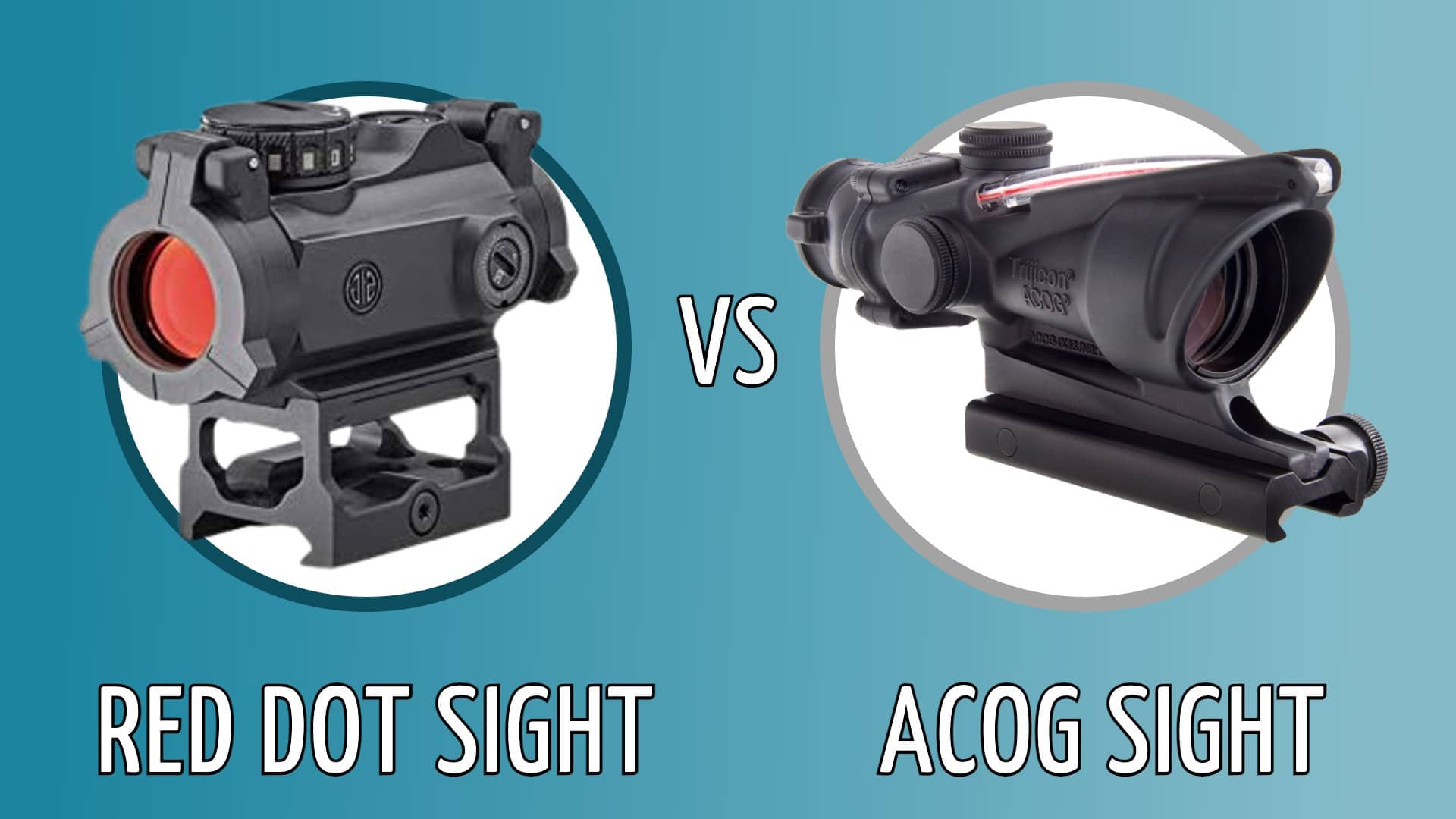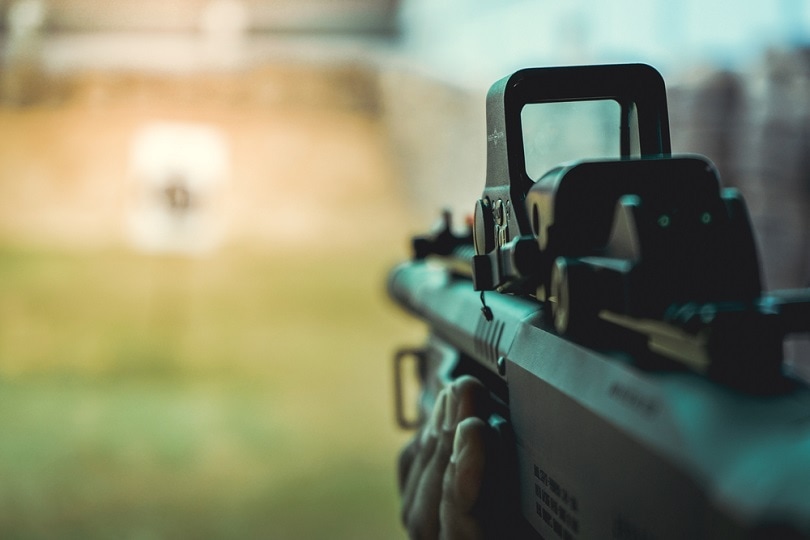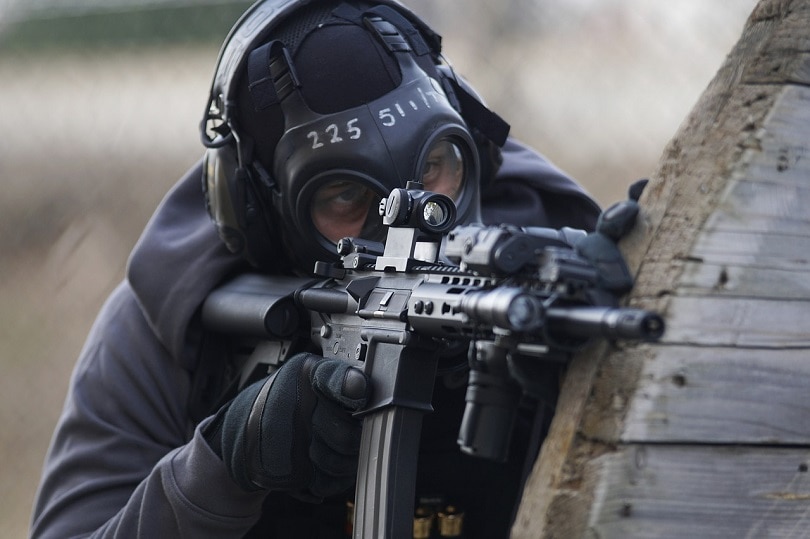Red Dot vs ACOG Sights: Which Is Better?
Last Updated on

Introduction
You’ve seen the tactical side of the movies where the military is using different optics. What on earth are they, though? Well, that would be either a red dot or an advanced combat optical gunsight (ACOG). One is designed for the regular non-military person and the other was made with combat in mind. Both are useful and both have their own set of pros and cons. Knowing what each can do for you is going to help you know which is better for you. Both are extremely amazing optics, but each has a place.
Let’s look at them both and see which is better for your needs.

Overview of Red Dot:

How it Works
The red dot is exactly what it sounds like. It is a red dot, though sometimes green, sighting system that uses the reticle as the aim point. There are different options on the market, including a holographic sight, but the principle is the same. The main difference between them is what image you will see and the price of the optic.
The red dot uses a LED to project a reticle onto a lens that is coated to only reflect red or green light. As you look through the lens, the coating absorbs the other colors, leaving you with just the red or green light coming towards you. If someone were to look through the opposite side, they would only see your eye and not the red dot.
In essence, the red dot is just a trick of the light, leaving you with a perfect dot to aim for. Depending on the optic, there are options on making it brighter or dimmer depending on your needs.
What it’s Good for
The best place for this optic is short-range shooting or defense. This type of sight wasn’t made for long-distance shooting. To get the most out of your optic, it is best used between 0 and 100 yards. It is designed to be a just point and shoot, and you know you are going to hit your target no matter what.
Red dots allow you to keep both of your eyes open. The way they are designed, you are getting a reflection of the light, meaning you don’t have to focus and only use your dominant eye for focus. Since there is no eye relief, you can monitor your surroundings as well. Basically, if you can see the dot, you can hit your target and that makes it a popular optic for defense and short-range.
These optics are great in low-light settings as well. In most of the red dot optics, you can change how intense the dot is showing. The brighter the light, the more likely you’ll need to raise the brightness to see it. At night you won’t need something as bright and can dim it down to find the correct balance.
- Beginner friendly
- Adjustable to different light settings
- Keep both eyes open
- Different colors available
- Keep area awareness
- Not for long-distance
- Not as rugged

Overview of ACOG:

How it Works
The most often ACOG is the Trijicon ACOG, which is a magnified scope. Like other optics on the market, it has various zoom options, but the one used the most is 4x magnification. Like the red dot, it uses an illuminated reticle that projects an image onto the target. That isn’t the only thing it does, though.
The ACOG is famous for including an incredibly precise bullet drop compensator. This makes it possible to use this optic for distance and makes hitting a human-sized target a breeze at about 500 yards. Therefore the Marine Corps favors this type of optic over just the red dot.
Unlike most optics though, this one is shorter. It was made for firearms with shorter barrels losing no effectiveness.
What it’s Good for
These optics are built like tanks. They last and go through just about any condition you can imagine. This makes them perfect for military personal and those who hunt in different weather conditions. Because the ACOG is also a magnified optic, it doubles as not just a tool to aim with but also one that can observe and a spotter. This makes it perfect for anything above 100 yards.
The optic provides a crystal-clear image and a bright picture. The BDC makes shooting simple and effective, no matter the conditions. The optic itself is waterproof, shockproof, and fog proof, making it a staple for any climate available.
The best part is the ACOG uses fiber optics and tritium to provide a battery-free light source that illuminates the reticle. The illumination will adjust to the right light level automatically, meaning you don’t have to worry about it. This makes it great for distance.
- Extremely durable
- Magnification
- No batteries to worry about
- Bullet Drop Compensator
- Pricey
- Weighs more than a red dot

Other Factors to Consider
Risk Management
It is always going to be safer to have both eyes open when handling a firearm. However, many optics on the market require you to close your non-dominant eye in order to use them. This is where the red dot really shines. It allows you to keep both eyes open, which keeps you alert to your surroundings.
Why do we close one eye, anyway? It comes down to minimizing the information sent to the brain. At least, that is what the idea is. It allows your brain to focus on the information that is being fed to it through the one eye that is focusing. The downside to this is it also reduces the amount of information you are receiving from the eye that is closed.
Taking a stressful situation, like defense, closing one eye goes against human nature. The brain wants to take in all the information it can in order to get you out of there safely. This is where the red dot shines, as it was built to keep both eyes open. The ACOG won’t allow that option, making it best for longer ranges.
Accuracy is Important
While normally the red dot would win out on this, it actually comes in behind the ACOG. The ACOG comes with the BDC, making it perfect for long-distance but also being able to hit your target. There is a reason the military is fond of this optic after all. It not only keeps the soldier safe, but also allows them to calculate a shot in seconds.
It truly comes down to distance. The farther something is from you, the best bet is going to be the ACOG. They are built for distance and for accuracy. The red dot is meant for short-range shooting. While both are accurate, it comes down to the distance you are looking at. Yes, it is possible to use the ACOG for short-distance shooting, but that isn’t ideal.
Ask yourself what distance you are going to be shooting at the most. Is it close range or something farther than that? Once you know the answer, it makes it easier to pick from.
Versatility Options

The winner in the category is the red dot. Red dots are simple, easy to use on any firearm, and there are so many options available you could easily find one that suited to your needs. That is the beauty of the red dot. It can even be magnified for some extra zoom. No matter what you are doing, the red dot can easily match your needs.
The ACOG doesn’t offer such versatile options, though. They are made to be used in tactical scenarios. It is why the Marines favor this optic over the simple red dot. Not only that, they are rugged and made to take a beating. They also don’t take batteries, making them easy to use in places where batteries are scarce.
The major downside is the more versatile the ACOG, the more money it is. Also depending on the type of environment, it will also depend on what you need. Consider where, and what you will use your firearm for and you’ll know which one is right for you.
In Conclusion
Regardless of what you choose, you will have an excellent option when it comes to your firearm. As long as you stick to the higher-end optics, you know you will get the best for your buck. Take into account what you will be doing and you’ll know the perfect options. The ACOG is great for the military person, while the red dot is perfect for the everyday person.
Featured image credit: Anatoly Vartanov and Creation Media, Shutterstock
About the Author Robert Sparks
Robert’s obsession with all things optical started early in life, when his optician father would bring home prototypes for Robert to play with. Nowadays, Robert is dedicated to helping others find the right optics for their needs. His hobbies include astronomy, astrophysics, and model building. Originally from Newark, NJ, he resides in Santa Fe, New Mexico, where the nighttime skies are filled with glittering stars.
Related Articles:
Holy Stone Drone Review of 2024 – Pros, Cons, and Verdict
Ultraviolet Light vs Black Light: What’s the Difference?
Light Waves vs. Sound Waves: The Key Differences
Infrared vs. Thermal Cameras: How Are They Different?
Far Infrared vs Near Infrared: What’s The Difference?
Mottled Duck vs. Mallard vs. Black Duck: What’s the Difference?
Shutter Speed vs Frame Rate: Pros, Cons, & Difference
Oriole vs Goldfinch: How to Tell the Difference
